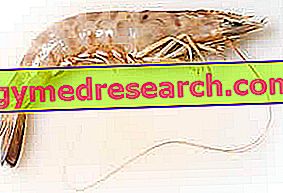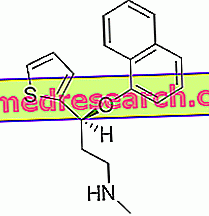Generality
Shrimps are sea fishing products that match the appearance of large shrimp.
Classification of shrimp: the shrimp are therefore Macruri Crustaceans which, according to the traditional zoological classification, belong to the Decapoda Order, Penaeidae family, Genus Penaeus .

For some types of shrimp has been proposed by Pérez Farfante and Kensley (but not yet validated) an alternative classification that provides for the reorganization of twenty-two Species traditionally belonging to the only Genus Penaeus in five Genres, respectively: Penaeus, Farfantepenaeus, Fenneropenaeus, Marsupenaeus and Litopenaeus . In addition, 6 other species belonging to the genus Penaeus have been reclassified under the genus Melicertus ( canalisculatus, latisulcatus, longystilus, marginatus, plebejus and also the aforementioned kerathurus )
Among the various types of shrimp, the most important globally is without Penaeus monodon, also known as " giant tiger shrimp ".
Description of shrimp: the Mediterranean shrimp are elongated, with an anterior portion, called cephalothorax, which contains the nervous system and most of the organs; from the cephalothorax the antennas, the eyes, the toothed beak etc. are prolonged anteriorly, and inferiorly some legs called pereiopods . The posterior portion of the crustacean (the edible one) is constituted by the whole abdomen divided into six segments, from which some small pinnute paws called peleopods prolong inferiorly. At the rear a large segmented caudal portion ( uropods ) is used, mainly used in escape actions. The whole body of the shrimp is covered by a chitinous layer called carapace .
The shrimp of the Mediterranean are clear, with an oscillating bottom between gray and pink and brown or red streaks. The pigmentation can change depending on the depth, the size of the crustacean and the catch area. They can reach 100g in weight for about 20cm in length.
Peach and shrimp habitat: the shrimp are crustaceans that live resting on the bottom of extremely changeable depths (from a few meters to over 50) depending on the age of the specimens, the season and the area concerned. They prefer a sandy or muddy soil and not very far from the coast, since the young specimens mainly colonize the areas of the river mouths and then sink gradually. Shrimp feed mainly on plankton and their natural predators are cephalopod fish and molluscs; professional fishing for shrimp is performed mainly with the trawl technique.
Hygienic aspects
Shrimp are sensibly perishable foods. During the conservation of the fresh product (temperatures> 0 ° C), an enzymatic degradation of the free amino acids and of the muscle proteins takes place in a manner that is, to say the least, rapid. This causes the onset of a pungent ammonia odor, possibly (but not necessarily) accelerated by bacterial proliferation. Enzymatic degradation can be stopped by cooking or freezing.
Gastronomic characteristics
Shrimp are extremely welcome foods, perhaps the most marketed in the entire category of fishery products. They lend themselves to every type of culinary preparation: from the crudités to the boiled appetizers, from the composition of the first courses to the formulation of the dishes; probably the best-known shrimp-based recipes are grilled skewers and frying. The best food-wine pairing with shrimp varies considerably depending on the preparation; these are more or less full-bodied white wines, for example: Custoza white, Lugana, Vermentino di Sardegna, Fiano d'Avellino, Soave Classico, Vernaccia etc.
Nutritional properties
Nutritional properties of shrimp: let's start by specifying that shrimp are potentially allergenic foods, therefore not recommended in the diet of: pregnant women, nurses and children of post-weaning age.
Secondly, the shrimp provide significant amounts of cholesterol; this makes them unsuitable for those suffering from related hyperlipidemias, even if the total fatty acid content should turn to good (polyunsaturated) than potentially harmful (saturated) ones.
The energy intake is low, similar to that of chicken breast, and mainly supported by peptides with high biological value.
Among the vitamins, a good content of the water-soluble Niacin and the fat-soluble A, in the form of retinol equivalents (carotenoid astaxanthin) is shown.
With regard to mineral salts, the contributions of iron and calcium are good.
Whole shrimps contain a very high edible ration consisting essentially of the chitin carapace. Despite being non-digestible for humans, through a specific alkaline treatment, chitin is converted into chitosan, a molecule used as a slimming food supplement. This product should act as a lipid chelator in order to reduce intestinal fat absorption. NB . The effectiveness of chitosan has not yet been demonstrated.
Nutritional values
Nutritional composition for 100g of Shrimps, fresh and of Shrimps, shelled, frozen - Reference Values of Food Composition Tables - INRAN
 | |||
| Shrimp, fresh | Shrimps, shelled, frozen | ||
| Edible part | 45.0% | 100.0% | |
| water | 80.1g | 80.2g | |
| Protein | 13.6g | 16.5g | |
| Prevailing amino acids | - | - | |
| Limiting amino acid | - | - | |
| Lipids TOT | 0.6g | 0.9g | |
| Saturated fatty acids | - | - | |
| Monounsaturated fatty acids | - | - | |
| Polyunsaturated fatty acids | - | - | |
| Cholesterol | 150.0mg | 150.0mg | |
| TOT Carbohydrates | 2.9g | 2.9g | |
| Starch | 0.0g | 0.0g | |
| Soluble sugars | 2.9mg | 2.9mg | |
| Dietary fiber | 0.0g | 0.0g | |
| Soluble | 0.0g | 0.0g | |
| Insoluble | 0.0g | 0.0g | |
| Power | 71.0kcal | 85.0kcal | |
| Sodium | 146.0mg | 375.0mg | |
| Potassium | 266.0mg | 75.0mg | |
| Iron | 1.8mg | 2.6mg | |
| Football | 110.0mg | 128.0mg | |
| Phosphorus | 349.0mg | 150.0mg | |
| Thiamine | 0.08mg | tr | |
| Riboflavin | 0.10mg | 0.02mg | |
| Niacin | 3.20mg | 0.5mg | |
| Vitamin A | 2.0μg | tr | |
| C vitamin | 2.0mg | tr | |
| Vitamin E | - mg | - mg | |



